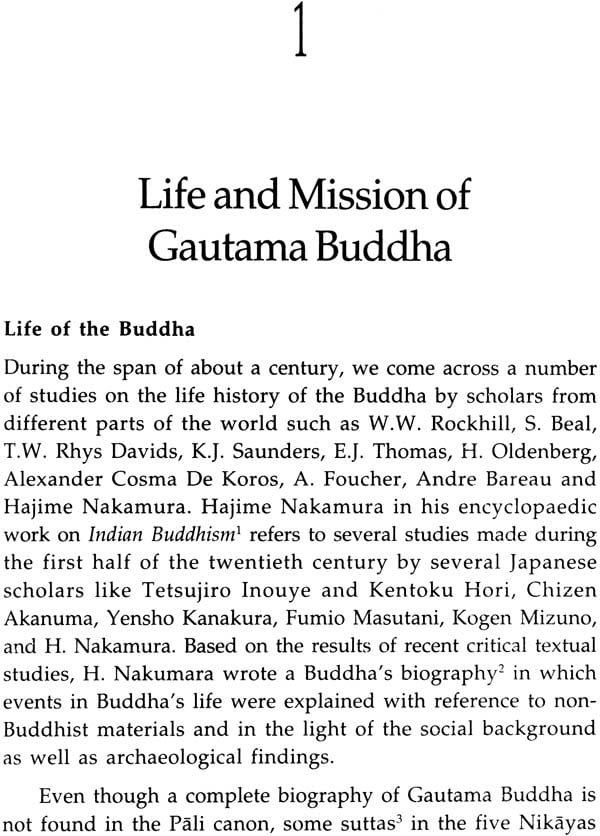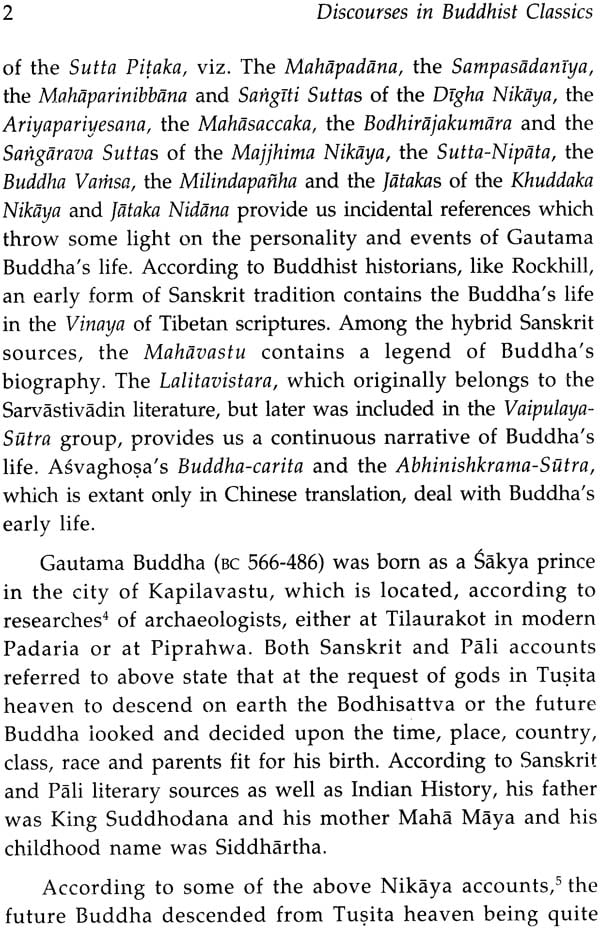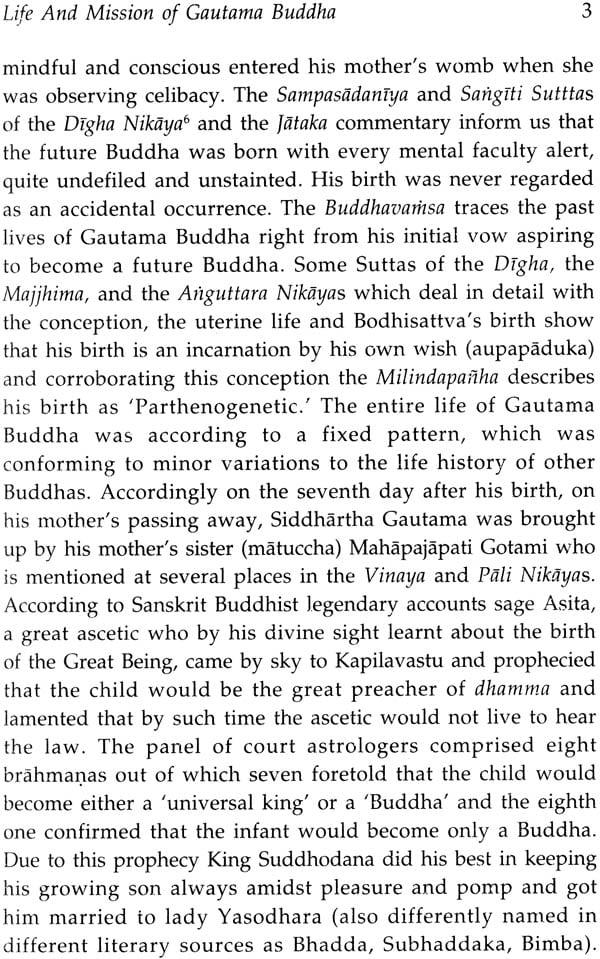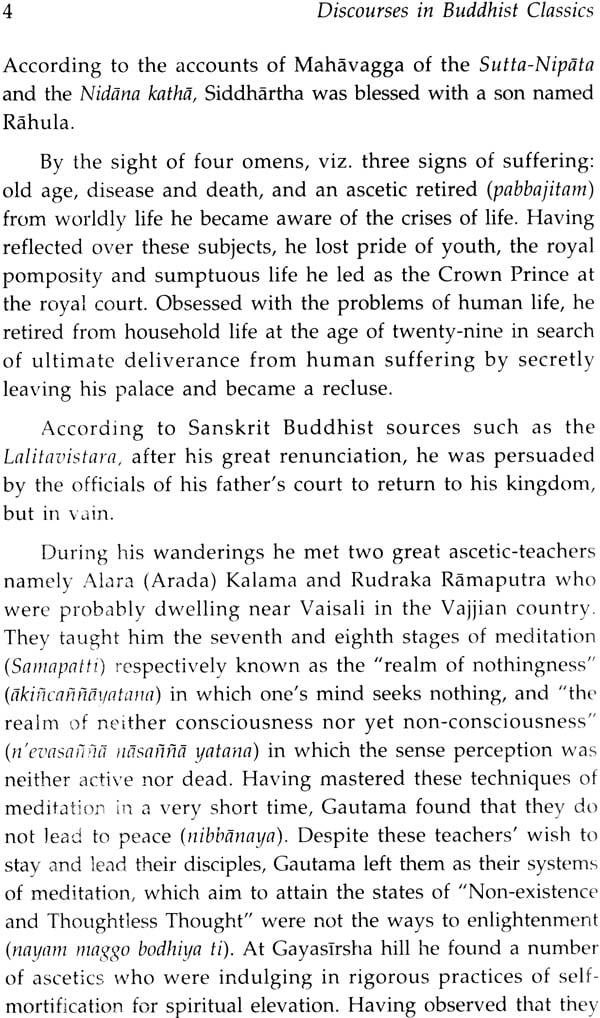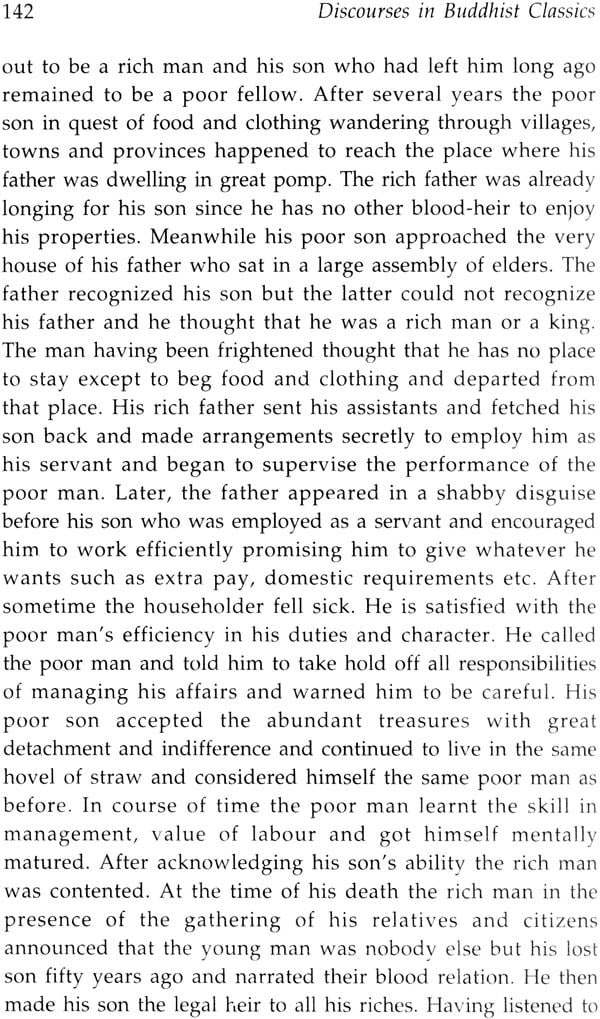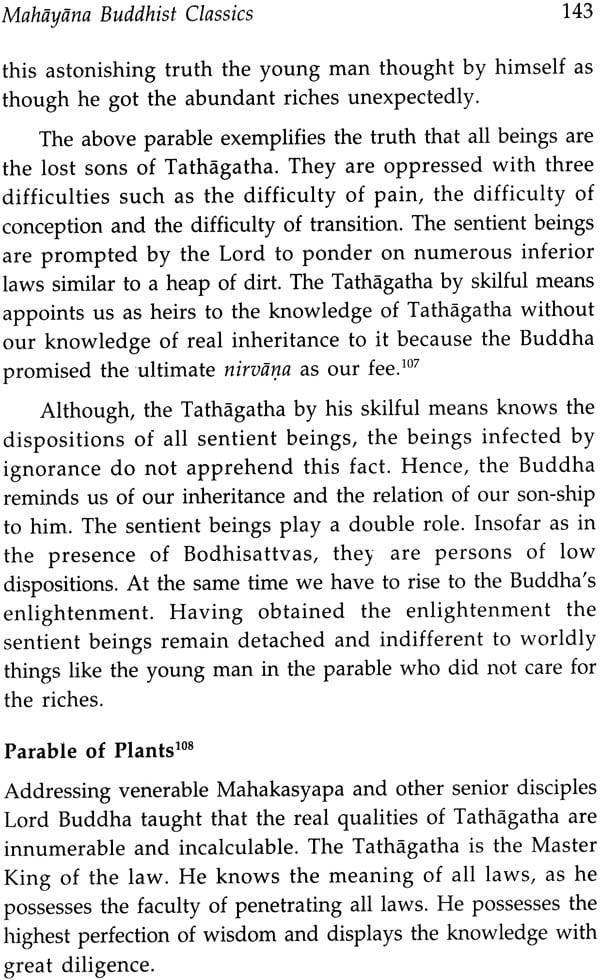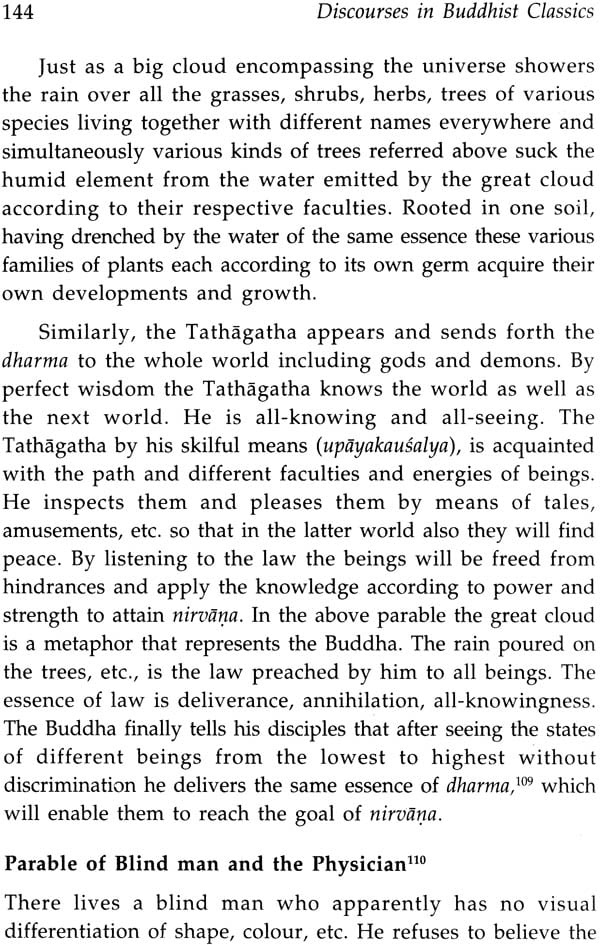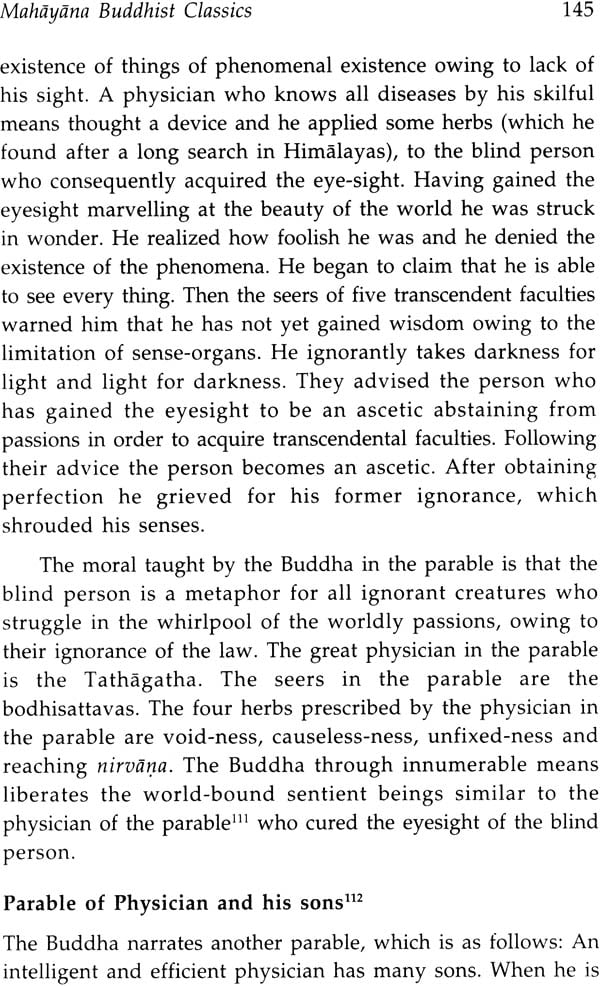
Discourses in Buddhist Classics
Book Specification
| Item Code: | IHF048 |
| Author: | V.V.S. Saibaba |
| Publisher: | D. K. Printworld Pvt. Ltd. |
| Language: | English |
| Edition: | 2006 |
| ISBN: | 812460360X |
| Pages: | 186 |
| Cover: | Hardcover |
| Other Details | 8.8”X 5.8” |
| Weight | 430 gm |
Book Description
From the Book
Discourses in Buddhist Classics is primarily designed with twofold objective viz., (a) to serve as the tool for post-graduate teaching of the Course in “Philosophy of the Buddha”; and (b) to sustain the interest of the enter-prising student by providing comprehensive understanding of Theravada and Mahayana schools of Buddhism.
Divided into six chapters, the first chapter gives an account of the missionary life and object of Buddha’s teachings from Pali and Sanskrit sources; the second surveys the evolution of Pali language and its significant contribution; the third and fourth provide a brief sketch of Pali Tripitakas, the salient features as well as the Philosophical doctrines of Theravada and Mahayana Buddhism by comparison and contrast. The last two chapters discuss the historiography of the two representative Buddhist Classics each from Theravada and Mahayana philosophical schools of Buddhism viz., Dhammapada, Sutta-Nipata, Vajracchedika Prajnaparamita and Saddharma Pundarika Sutra while throwing light on their central teachings.
This work serves as a useful companion for the scholars and researchers who are seriously interested in the history of Buddhist literature; who wish to probe into Buddhist Textual Studies and who desire to have a lucid understanding of the philosophy of the two major Buddhist traditions of Theravada and Mahayana.
Dr. Saibaba V.V.S. (1947-) Professor at Department of Philosophy and Religious Studies, Andhra University, Visakhapatnam wherefrom he holds his Master’s degree (1973), and PhD degree (1985). He was Head of the Centre for Mahayana Buddhist Studies at Acarya Nagarjuna University (1987-89). He taught Buddhist Sanskrit texts, philosophy of the Buddha, Scriptural readings, Indian philosophy and Sankaradvaita. He has participated in several International and National Conferences and supervised research on Jaina and Buddhist Philosophical texts, Buddhist history, Art, Architecture, Literature, Judaism, catholic Christianity, Hatha Yoga and Dvaita Vedanta. His other publications include Facets of Buddhist Philosophy: Theravada and Mahayana; Faith and Devotion in Theravada Buddhism; Theravada Buddhist Devotionalism in Ceylon, Burma and Thailand; Studies in Vedanta (co-editor); many research papers in international and national journals of Buddhism and philosophy.
Foreword
The primary object of this monograph is to describe the basic teachings of the Buddha as enshrined in the Theravada and Mahayana literature. For gleaning materials expounding Theravada teachings Prof. Saibaba ahs selected two books viz, the Dhammapada a very popular book containing the jewels of ethical teachings, and the Suttanipata - a text regarded as very ancient on the grounds of language and content. The representative texts selected for describing Mahayana teachings are the Saddharmapundarika Sutra and the Vajracchedika Prajnaparamita.
In the first four chapters of the monograph the author tries to prepare the readers for appreciating the Buddha’s teachings in their early and developed form. So by way of introducing his teachings the author devotes the first chapter of his book to trace the life of Gautama the Buddha, his teachings as found in the early Buddhist literature and also the object of his teachings based on Pali and Sanskrit sources. The second chapter is devoted to survey the evolution of Pali language and literature. The third chapter briefly sketches the three divisions of the Pali Tipitaka viz., the Vinaya, the Sutta and the Abhidhamma Pitakas. In the fourth chapter the readers are informed about the fundamental principles of Theravada; the origins of Mahayana Buddhism; hw the term Mahayana originated and what its salient features are; and the points of agreement and disagreement between Theravada and Mahavana.
Chapter five takes up the four Vaggas from the Dhammapada viz., The Arahanta, the Buddha, the Magga and the Bhikkhu. In the Arahanta vagga the qualities of an Arhant are brought out in the following gatha:-
sammadannavimuttassa, upasantassa tadino ||
i.e. Calm is his mind, calm is his speech, calm is his action, who rightly knowing is wholly freed, perfectly peaceful and equipoised.
In the Buddha vagga the teachings of the Buddha have been beautifully summarized in the following gatha:
sacittapariyodapanam, etam Buddhanusasanam ||
Not to do any evil, to cultivate good, to purify one’s mind - this is the Teaching of the Buddhas.
The Magga vagga besides saying that the eightfold path is the best of all paths, four noble truths are the best of truths, non-attachment is the best of states, and the Buddha…the all-seeing one is the best of bipeds also contains the quintessence of the Buddha’s teachings. When one discerns these with wisdom (panna), then one is disgusted with misery. This is the path to purity.
Because wisdom arises from meditation and wanes without it, so one should conduct oneself in such a way that wisdom may increase.
etam dvedha patham natva, bhavaya vibhavaya ca |
tathttanam niveseyya, yatha bhuri pavaddhati ||
The Buddha makes it clear that everybody has to walk upon the eightfold path an work out his own salvation.
Nobody else, not even he can do it for anybody else. For walking upon the path, purity of three kinds of action is a sine qua non.
In the Bhikkhu vagga restraints of all kinds i.e. restraints in all the sense-organs and restraints in all the three kinds of action are said to be the necessary qualities of a bhikkhu. Besides, other qualities of a bhikkhu are brought out in this Vagga.
In the second section of chapter five, the author has selected texts from the Suttanipata such as Khaggavisana Sutta, Atthaka Vagga, and Parayana Vagga. The ideals of a Paccekabuddha are described in fortyone powerful stanzas in the Khaggavisana Sutta. Each stanza has the refrain “May he wander alone like the horn of a rhinoceros” (eko care khaggavisanakappo). The ideals of early Buddhism are set forth here in a very lucid but powerful manner. The other two texts selected by the author as representative of Theravada literature are also very ancient because they along with the Khaggavisana Sutta have two commentaries called Maha Niddesa and Culla Niddesa which are included in the canon itself. Their antiquity is also proved by the fact that they are found in the Chinese Agamas. Fragments of the Sanskrit version of the two texts have also been found in Eastern Turkestan as said by M. Anesaki. The Atthaka vagga is mentioned as the Arthavargiyani Sutrani in the Divyavadana. In the Atthaka vagga also the characteristics of a muni have been enumerated. In the Paramatthaka Sutta it has been asserted that truth is not dependent on any ditthi (view) but it transcends all views. How close this view is to the view expressed by the Buddha is explained in the Brahmajala Sutta. The Buddha says there that he knows all the views mentioned here and knows even beyond them but he is not attached to any of them.
pajanati tam ca pajananam na paramasati, aparamasato cassa paccattanneva nibhuti vidita ||
The Parayana Vagga contains the dialogue between the sixteen disciples of Brahmana Bavari and the Buddha on profound philosophical and sublime ethical subjects. It is clear from these texts that the author has been very careful in selecting them as they are ancient and have enshrined in them the original teachings of the Buddha such as the four noble truths, the eightfold path, and the tilakkhana. One who observes the five precepts (sila), practices meditation (Samadhi) and attains wisdom (panna) by realizing the true nature of things at the experiential level is bound to end suffering and attain liberation.
In chapter six the texts depicting the salient features of Mahayana Buddhism are taken from the Vajracchedika Prajnaparamita and the Saddharmapundarika Sutra which are representative texts of Mahayana Buddism. M. Winternitz rightly says that “he who wishes to become acquainted with Mahayana Buddhism, with all its characteristic peculiarities, with all its advantages and defects, should read this Sutra (i.e. the Saddharmapundarika Sutra). There is not much of the man Sakyamuni left in this work. The Buddha now is actually nothing less than a God above all gods, an infininitely exalted being who has lived since countless aeons in the past and will live for ever.” Here we see the refutation of the early pronouncement of the Buddha that “I won’t be born again.” Unlike the Buddha of the Pali canon, the Buddha of the Lotus Sutra speaks just like the Krsna of the Bhagavad Gita and showers compassion on his devotees. The Mahayana teachings have been explained through the Parables of the Saddharma Pundarika.
In the Vajracchedika Prajnaparamita the Mahayana doctrine is at its best. One is just to select only one four-footed verse from the Vajracchedika and explain it to others to acquire greater religious merit than a person who might sacrifice his life day by day for aeons. The tone the tenor of these texts are quite unlike those of the Theravada texts where men are asked to be pure by driving out all defilements and strive hard for ending their misery. According to these texts, on the other hand, freedom from misery is attained just by reciting the names of the Buddhas and the Bodhisattvas.
The author who has already published three books in the field of Buddhist thought is very well qualified to choose gathas and suttas from a great mass of literature. He has brought his expertise to bear upon the selection of the Four Texts from Theravada and Mahayana, highlighting their objectives and differences as also bringing out their different aesthetics. This is a very useful monograph for any serious reader who wants to know about Early Buddhism and Mahayana. Prof. Saibaba deserves our congratulations and I wish him godspeed in his future academic endeavors.
Preface
The work entitled Discourses in Buddhist Classics has been initially undertaken under the Phase-II of U.G.C. Special Assistance Programme in the Department of Philosophy and Religious Studies, Andhra University, Visakhapatnam. Is primarly designed with two-fold objective: (a) To serve as the reading material for Final P.G. Students in the Department, an as the course material for the students of Distance Education who opt for the Philosophy of The Buddha as one of their special papers, and (b) To sustain the interest of the enterprising student by providing comprehensive understanding of the themes concerning the syllabi.
The object of the work is to describe the basic teachings of the doctrines of Theravada and Mahayana branches of Buddhist philosophy, with the aid of the four representative Buddhist Classical texts, viz. the dhammapada, the Sutta-Nipata, the Vajracchedika Prajnaparamita and the Saddharmapundarika-Sutra. The methodology employed in writing this monograph is mainly textual, analytical and also historical. The material covered in this monograph comprises the Andhra University syllabus prescribed for P.G. (Final) Philosophy students since 1972, introduced by my revered teacher Padma Vibhushan K. Satchidananda Murty.
The monograph is divided into six chapters whose contents are as follows:
Chapter 1 seeks to trace the life of Gautama Buddha, based on Pali and Sanskrit sources; his missionary life depicted in the Pali canon and the object of his teachings as reflected in the early Buddhist literature;
Chapter 2surveys the evolution of Pali language by throwing light on its antiquity; the stages of its development; the significant role of Pali language and literature as well as the contribution of scholars and institutions to Pali language and literature.
Chapter 3 provides a brief sketch of the main divisions of the Pali Tripitaka, viz. the Vinaya Pitaka the Sutta Pitaka and the Abhidhamma Pitaka.
Chapter 4 (Part 1) elucidates the fundamental principles of Theravada Buddhism which comprises the salient features of Theravada, the doctrines of Dependent Origination, Non-self, Karma and Rebirth, the Four Noble Truths and the Noble Eight-fold path. Part 2 of Chapter IV comprises the probable origins of Mahayana, the evolution of the term “Mahayana,” its salient features, and the points of agreement and disagreement between Theravada and Mahayana schools.
Chapter 5 (Part 1) furnishes the introduction of the dhammapada along with the lucid exposition of the contents in the text namely the Arhant, the Buddha, the Way and the Bhiksu. Part 2 of Chapter V deals with the main teachings of the Sutta-Nipata, original teachings of the Buddha and also it makes a study of the Buddha’s teachings contained in the Khaggavisana Sutta (from the Uraga Vagga) the “Book of Octades” (Atthaka Vagga) and the “Book of Way-Across” Parayana Vagga.
Chapter 6 (Part 1) discusses the Central teachings of the Vajracchedika Prajnaparamita-Sutra, the ideal of Bodhisattva in the Sutra and the characteristics of the conditioned Phenomena explained through nine similes. Part 2 of Chapter 6 contains an introduction and exposition of the Central teachings of the Saddharma Pundarika, viz. the Ideal of Tathagata in the Lotus-Sutra; the doctrine of universal salvation; Buddhahood as the highest goal of perfection; the doctrine of Single Vehicle (Eka-yana); the role of Bodhisattvas as Enlighteners and Saviours; the Doctrine of salvation by Faith and Devotion. It also examines the Philosophical significance of the Parables in the Lotus-Sutra.
My deepest debt of gratitude goes to my revered teacher Padma Vibhushan K. Satchidananda Murty, a profound scholar of international repute who has not only lectured during the year 1972-73 on the themes covered in this monograph but also with depth of vision promoted Buddhist philosophy by supervising my Ph.D project which enabled me to make an intensive study of the Buddhist classical texts, dealt in this work. my special thanks are due to P. George Victor, Co-ordinator UGC-Special Assistance Programme, Department of Philosophy for his keen interest and constant persuasion without which this work would never have been completed.
I am indebted to Angraj Chaudhary, Nava Nalanda Mahavihara for writing a foreword to this book. I deeply appreciate my sons V.S.V.S. Murthy, Vijaya Manjusri Maitreya and Shri P. Kishore Kumar, Dept. of Philosophy, Andhra University for all their valuable assistance and spirit of cooperation in computerizing the monograph without which this work would not have been brought to this state of completion. I gratefully acknowledge the generous service rendered by Shri Susheel K. Mittal of D.K. Printworld (P) Ltd., New Delhi for bringing out this book under the series of Andhra University Philosophical Studies.
| Foreword - Angraj Chaudhary | 5 | |
| Preface | xi | |
| Transliteration Chart | xviii | |
| 1 | Life and Mission of Gautama Buddha | 1 |
| Life of the Buddha | 1 | |
| Buddha’s Missionary Life | 6 | |
| Mission of the Buddha | 8 | |
| 2 | Origin and Development of the Pali Language | 12 |
| Definitions of the word Pali | 12 | |
| Date and Antiquity of the Pali Language | 13 | |
| Theories on the Evolution of the Pali | 14 | |
| Views of Scholars on the original home of Pali language | 17 | |
| Stages in the development of Pali language | 21 | |
| Contribution of Scholars and Institutions to Pali Language and Literature | 22 | |
| Significance of the Study of Pali Language | 23 | |
| 3 | The Tripitaka Literature | 27 |
| Vinaya Pitaka | 27 | |
| Sutta Pitaka | 27 | |
| Abhidhamma Pitaka | 33 | |
| 4 | Theravada and Mahayana Buddhism | 35 |
| Theravada Buddhism | 35 | |
| Salient features of Theravada | 35 | |
| Doctrine of Dependent Origination | 36 | |
| Doctrine of Non-self (Anatta) | 38 | |
| Doctrine of Karma and Rebirth | 39 | |
| Doctrine of Four Noble Truths | 41 | |
| Doctrine of Noble Eight-Fold Path | 42 | |
| Mahayana Buddhism | 44 | |
| Emergence of Mahayana, its home and antiquity | 44 | |
| Meaning and Justification of the term Mahayana | 47 | |
| Salient features of Mahayana Buddhism | 49 | |
| Points of Agreement between Theravada and Mahayana | 53 | |
| Principal differences between Theravada and Mahayana | 54 | |
| 5 | Theravada Buddhist Classics | 59 |
| I. Dhammapada | 59 | |
| Introduction | 59 | |
| Venerable or Arhat | 62 | |
| Awakened or Buddha | 63 | |
| Way or Magga | 65 | |
| Mendicant or Bhikkhu | 67 | |
| II. Sutta-Nipata | 70 | |
| Introduction | 70 | |
| Central Teachings | 74 | |
| Uraga Vagga : Rhinoceros Sutta | 81 | |
| (Khaggavisana Sutta) | ||
| Book of Octades (Atthaka Vagga) | 85 | |
| Book of the Way-Across (Parayana Vagga) | 92 | |
| 6 | Mahayana Buddhist Classics | 104 |
| I. Vajracchedika Prajnaparamita-Sutra | 104 | |
| Introduction | 104 | |
| Central Teachings | 110 | |
| Ideal of Bodhisattva | 117 | |
| Characteristics of the conditional Phenomena | 122 | |
| II. Saddharma-Pundarika-Sutra | 126 | |
| Introduction | 126 | |
| Central Teachings | 130 | |
| Ideal of the Tathagata | 131 | |
| Doctrine of Universal Salvation | 133 | |
| Buddha-hood as the highest goal of Perfection | 134 | |
| Doctrine of One Vehicle (Eka-yana) | 135 | |
| Role of Bodhisatvas as Enlighteners and Saviours | 137 | |
| Doctrine of Salvation by Faith and Devotion | 137 | |
| Philosophical significance of the Parables | 138 | |
| Parable of the Burning House | 140 | |
| Parable of the Prodigal Son | 141 | |
| Parable of Plants | 143 | |
| Parable of Blind man and the Physician | 144 | |
| Parable of Physician and his sons | 145 | |
| Bibliography | 148 | |
| Index of Pali and Sanskrit Works | 154 | |
| Index of Technical Terms and Proper Names | 159 |
